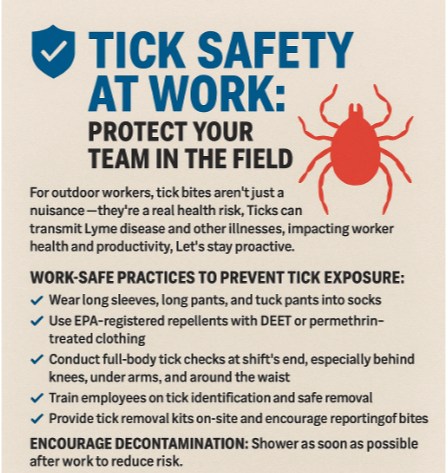Tick Safety at Work: Protect Your Team in the Field
July 2, 2025
For outdoor workers, tick bites aren’t just a nuisance—they’re a real health risk. Ticks can transmit Lyme disease and other illnesses such as Alpha-Gal Syndrome, a type of food allergy that makes people allergic to red meat and other products from mammals. This impacts worker health and productivity. Let’s stay proactive.
Work-Safe Practices to Prevent Tick Exposure:
• Wear long sleeves, long pants, and tuck pants into socks or boots
• Use EPA-registered repellents with DEET or permethrin-treated clothing
• Conduct full-body tick checks at shift’s end, especially behind knees, under arms, and around the waist
• Train employees on tick identification and safe removal
• Provide tick removal kits on-site and encourage reporting of bites
Encourage Decontamination: Shower as soon as possible after work to reduce risk.
Supervisors:
• Review site conditions regularly (e.g., tall grass, wooded areas)
• Ensure PPE compliance
• Schedule safety briefings during tick season (spring–fall)
• Early detection matters—report any tick-borne symptoms (fever, rash, joint pain) to a supervisor or health provider right away.
Safety isn’t seasonal. Let’s keep the job site tick-smart.
